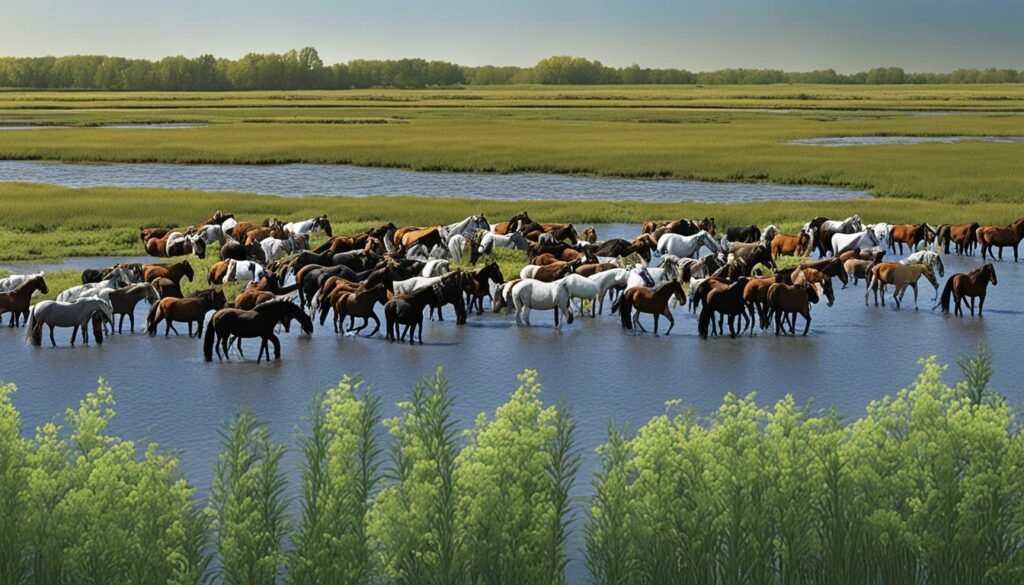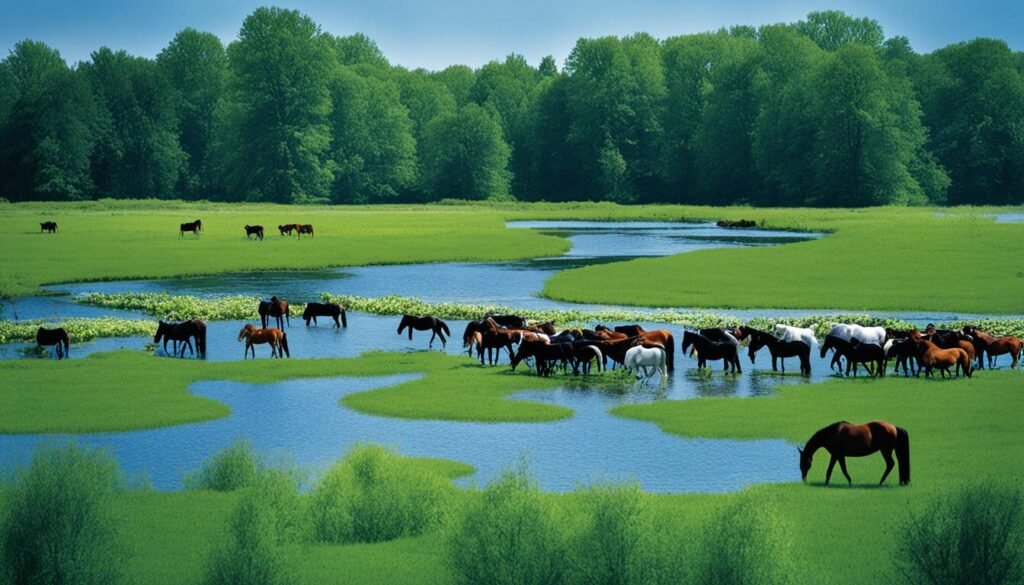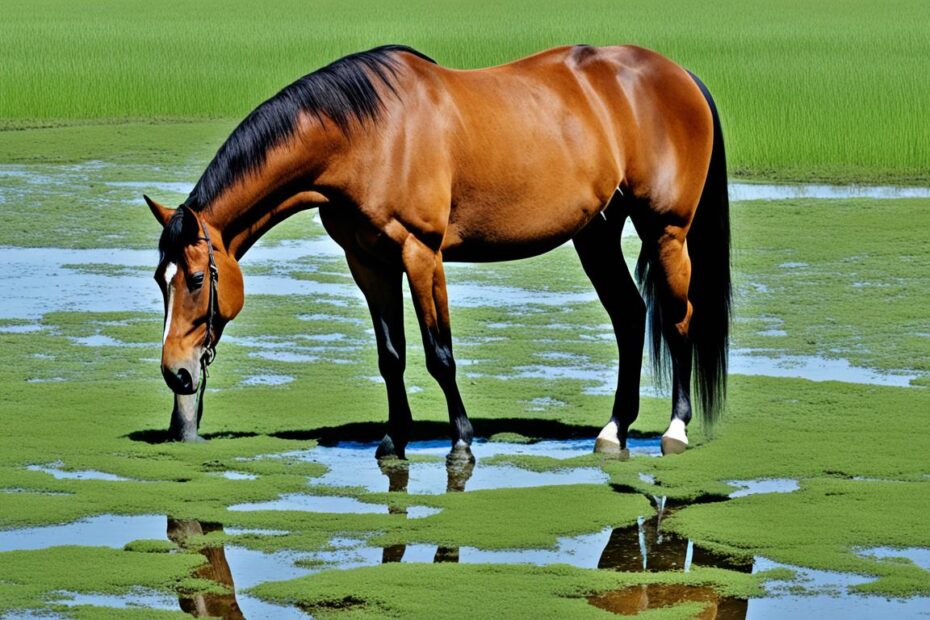Wetlands are delicate and dynamic ecosystems that play a crucial role in maintaining the balance of our natural world.
However, the introduction of horses into these sensitive environments can trigger a series of unseen biochemical changes that ripple through the entire system, causing far-reaching consequences.
This article delves into the hidden impact of horses on wetland ecosystems, exploring the intricate interplay between equine presence and the disruption of vital ecological processes.
Key Takeaways
- Horses can significantly impact the biochemical composition of wetland ecosystems, leading to nutrient loading, altered vegetation patterns, and disruption of aquatic nutrient cycling.
- Fecal contamination and the introduction of invasive species are other key concerns associated with the presence of horses in wetland environments.
- Sustainable equestrian practices, such as proper manure management and rotational grazing, are essential to mitigating the negative effects of horses on wetland habitats.
- Effective riparian zone management, including the establishment of buffer zones and strategic fencing, can help protect the delicate balance of wetland ecosystems.
- Understanding the complex interplay between horses and wetland ecology is crucial for ensuring the long-term preservation of these valuable natural resources.
Understanding Wetland Ecosystems
Wetland ecosystems are intricate and vital habitats that play a crucial role in maintaining the delicate balance of our natural world.
These diverse environments, often found along the borders of rivers, lakes, and coastlines, are home to a rich tapestry of plant and animal life, serving as a vital link between aquatic and terrestrial systems.
Importance of Wetlands
Wetlands are more than just scenic landscapes; they provide a range of essential ecological functions that benefit both the environment and human communities.
These dynamic ecosystems serve as natural water filters, trapping sediments and absorbing excess nutrients, and they also help to mitigate the impact of floods and storms by acting as natural flood barriers.
Ecological Functions of Wetlands
- Habitat for diverse flora and fauna
- Water filtration and purification
- Flood and storm damage reduction
- Carbon sequestration and storage
- Groundwater recharge and discharge
Understanding the complexity and importance of Wetland Ecosystem Disruption is crucial for ensuring the long-term health and resilience of these vital natural resources.
By recognizing the delicate balance of wetland ecosystems and adopting sustainable Riparian Zone Management practices, we can work to preserve these invaluable habitats for generations to come.
Equine Environmental Impact
Horses, a beloved part of many cultures and landscapes, have a significant impact on the environment. As we delve deeper into the intricate relationship between equine presence and wetland ecosystems, it’s crucial to understand the broader implications of the Equine Environmental Impact.
Horses are grazers, and their grazing habits can significantly alter the delicate balance of wetland habitats. Their hooves can compact soil, leading to increased erosion and disruption of the natural drainage patterns.
Additionally, the waste produced by horses can contribute to nutrient loading, which can have far-reaching consequences for the entire ecosystem.
| Environmental Impact | Description |
|---|---|
| Soil Compaction | Horses’ hooves can compact soil, leading to reduced water infiltration and increased runoff. |
| Nutrient Loading | Horse waste can contribute to an excess of nutrients in the water, causing eutrophication and disrupting the natural balance. |
| Vegetation Changes | Grazing patterns can alter the composition and diversity of wetland plant communities, leading to the dominance of certain species. |
| Habitat Fragmentation | The presence of horses and associated infrastructure, such as fencing and stables, can fragment the natural landscape and disrupt the connectivity of wetland habitats. |
By understanding the Equine Environmental Impact, we can better appreciate the complex interplay between horses and the delicate wetland ecosystems they inhabit.
This knowledge will inform the development of sustainable equestrian practices and guide the implementation of effective management strategies to protect these vital natural resources.
Horse-Induced Biochemical Changes in Wetlands
The presence of horses in wetland ecosystems can have a profound impact on the delicate biochemical balance of these environments.
One of the primary concerns is the issue of nutrient loading, which occurs when the waste produced by these animals introduces excessive amounts of nutrients like nitrogen and phosphorus into the water.
Nutrient Loading
Equine waste can be a significant source of nutrients, and when it accumulates in wetland areas, it can lead to a phenomenon known as eutrophication.
This process involves the rapid growth of algae and other aquatic plants, which can eventually deplete the available oxygen in the water, threatening the survival of other aquatic life.
Altered Vegetation Patterns
The influx of nutrients can also lead to changes in the vegetation patterns within the wetland. Certain plant species may thrive in the nutrient-rich conditions, while others may be outcompeted or unable to adapt to the altered ecosystem.
This shift in the plant community can have cascading effects on the entire food web, potentially facilitating the introduction and proliferation of invasive species.
| Impact | Description |
|---|---|
| Nutrient Loading | Equine waste introduces excessive nutrients like nitrogen and phosphorus, leading to eutrophication and oxygen depletion in the water. |
| Altered Vegetation Patterns | Nutrient-loving plants may thrive, while other species struggle, potentially enabling the spread of invasive species. |

These horse-induced biochemical changes in wetlands have far-reaching consequences, disrupting the delicate balance of these ecosystems and potentially paving the way for the introduction and proliferation of invasive species.
Understanding and addressing these issues is crucial for the long-term preservation of these vital natural resources.
Aquatic Nutrient Cycling Disruption
The presence of horses in wetland environments can have a significant impact on the delicate balance of aquatic nutrient cycling. Horse manure and urine introduce excess nutrients, such as nitrogen and phosphorus, into the water system.
This disruption in the natural nutrient cycling can lead to a host of environmental problems, chief among them being the risk of eutrophication.
Eutrophication Risks
Eutrophication is the process by which excess nutrients, particularly nitrogen and phosphorus, stimulate the rapid growth of algae and other aquatic plants. This unchecked plant growth can have devastating consequences, including:
- Algal blooms that can produce toxic substances and deplete oxygen levels in the water
- Decreased water clarity, which can hinder the growth of submerged aquatic vegetation
- Depletion of dissolved oxygen, leading to the suffocation of fish and other aquatic life
- Shifts in the composition of aquatic communities, favoring certain species over others
These changes can ultimately lead to the degradation of water quality, the loss of biodiversity, and the disruption of valuable ecosystem services provided by wetlands.
| Impact | Consequence |
|---|---|
| Excess Nutrient Loading | Algal Blooms and Eutrophication |
| Oxygen Depletion | Suffocation of Aquatic Life |
| Shifts in Aquatic Communities | Loss of Biodiversity and Ecosystem Services |
Understanding the risks of eutrophication and the disruption of aquatic nutrient cycling is crucial for developing effective management strategies to protect wetland ecosystems from the detrimental impacts of horse-related activities.
Fecal Contamination Effects
The presence of horse fecal matter in wetland environments can have far-reaching consequences that extend beyond the immediate area. One of the primary concerns is the potential for fecal contamination, which can have detrimental impacts on water quality, human and animal health, and the overall integrity of the ecosystem.
Fecal contamination can lead to the introduction of harmful pathogens, such as bacteria, viruses, and parasites, into the water system.
This can pose a significant risk to both human and animal populations that rely on the wetland for drinking water, recreational activities, or as a habitat. The consumption or exposure to contaminated water can result in a range of health issues, from gastrointestinal illnesses to more serious infections.
Additionally, the nutrients present in horse fecal matter can contribute to the problem of eutrophication, a process where excessive nutrients in the water can lead to the rapid growth of algae and other aquatic plants.
This can disrupt the delicate balance of the wetland ecosystem, potentially resulting in the depletion of dissolved oxygen, the loss of biodiversity, and the overall degradation of the aquatic environment.
| Potential Impacts of Fecal Contamination | Affected Stakeholders |
|---|---|
| Water Quality Degradation | Local Residents, Wildlife, Recreational Users |
| Human and Animal Health Risks | Local Residents, Livestock, Wildlife |
| Ecosystem Disruption and Biodiversity Loss | Wildlife, Vegetation, Wetland Habitat |
To mitigate the fecal contamination effects and protect the integrity of the wetland ecosystem, it is crucial to implement effective manure management practices and establish appropriate buffer zones and fencing to minimize the direct impact of horse activities on the sensitive wetland environment.
Invasive Species Implications
The horse-induced changes in wetland ecosystems can have far-reaching implications, including the introduction and proliferation of non-native, invasive species. These species can gain a competitive advantage and further disrupt the delicate balance of the wetland environment.
Introduction of Non-Native Species
As horses trample and disturb the wetland habitat, they can inadvertently introduce non-native plant and animal species.
These species may be brought in through the transport of seeds, eggs, or even in the fur or hooves of the horses. This can lead to the displacement of native species and the disruption of the natural ecosystem.
Competitive Advantages
- Invasive species often thrive in disturbed environments, taking advantage of the changes caused by horse activities.
- They may possess traits that allow them to outcompete native species for resources, such as faster growth rates, drought tolerance, or lack of natural predators.
- The introduction of these species can lead to a cascade of effects, as they disrupt the food web and alter the delicate balance of the wetland ecosystem.
The implications of invasive species on wetland ecosystems can be severe, leading to a decline in biodiversity, disruption of nutrient cycling, and the potential for long-term damage to the overall wetland ecosystem. Understanding and mitigating these impacts is crucial for preserving the ecological integrity of these vital natural habitats.

Riparian Zone Management
Effective management of riparian zones, the areas bordering wetlands, is crucial in mitigating the environmental impacts of equestrian activities.
By implementing strategic measures, we can safeguard these sensitive ecosystems and promote sustainable equestrian practices.
Buffer Zones and Fencing
A key aspect of riparian zone management is the establishment of buffer zones and fencing. Buffer zones, which are vegetated areas adjacent to wetlands, act as natural filters, trapping sediment, nutrients, and other pollutants before they enter the water.
Fencing, on the other hand, helps to control the access of horses to these sensitive areas, preventing overgrazing and trampling.
Properly designed and maintained buffer zones and fencing can significantly reduce the negative effects of horse-induced biochemical changes in wetlands. They help to preserve the delicate balance of these ecosystems, ensuring the continued provision of essential ecological functions.
| Benefits of Riparian Zone Management | Strategies for Effective Implementation |
|---|---|
| Protects wetland ecosystems from nutrient loading and eutrophication Prevents the introduction of invasive species Maintains the natural vegetation patterns and biodiversity Safeguards aquatic habitats and wildlife | Establish wide, well-vegetated buffer zones along wetland boundaries Install fencing to control horse access and prevent overgrazing Regularly monitor and maintain buffer zones and fencing Educate equestrian communities on the importance of riparian zone protection |
By prioritizing Riparian Zone Management and implementing effective strategies, we can safeguard the health and integrity of wetland ecosystems, while promoting sustainable Sustainable Equestrian Practices. This holistic approach is essential for preserving the delicate balance of these vital natural resources.
Sustainable Equestrian Practices
As equestrian enthusiasts, we have a responsibility to ensure our activities align with the conservation of wetland ecosystems.
Fortunately, there are several sustainable practices we can adopt to minimize the impact of horses on these delicate environments.
Manure Management
Proper manure management is crucial in maintaining the ecological balance of wetlands. Strategies like composting, regular removal, and strategic placement can prevent nutrient overloading and reduce the risk of eutrophication.
By implementing these measures, we can safeguard the water quality and support the thriving of native plant and animal species.
Rotational Grazing
Rotational grazing is an effective approach to managing the grazing patterns of horses in wetland areas. By moving horses to different sections of the land, we can allow for the regeneration of vegetation and prevent overgrazing.
This technique not only preserves the integrity of the riparian zone but also promotes the growth of diverse plant communities, supporting the overall health of the wetland ecosystem.
By embracing Sustainable Equestrian Practices and incorporating strategies like manure management and rotational grazing, we can minimize the impact of our equestrian pursuits on the delicate Riparian Zone Management.
Through our collective efforts, we can ensure that our beloved horses coexist in harmony with the natural wetland environments they inhabit.
Wetland Ecosystem Disruption
The equine-induced biochemical changes within wetland environments can have far-reaching consequences, disrupting the delicate balance of these precious ecosystems. The cascading effects of nutrient loading, altered vegetation patterns, and fecal contamination pose significant threats to the overall health and functionality of wetlands.
One of the primary concerns is the issue of nutrient loading. Horses’ waste products can contribute to an excess of nitrogen and phosphorus in wetland waters, leading to a process known as eutrophication.
This can result in harmful algal blooms, depletion of dissolved oxygen, and the displacement of native aquatic species, ultimately compromising the ecosystem’s ability to support a diverse and thriving community of plants and animals.
Equally troubling is the disruption to the natural vegetation patterns within wetland habitats. The grazing and trampling activities of horses can alter the composition and distribution of essential plant species, favoring the proliferation of invasive and non-native flora.
This shift in the vegetation landscape can have cascading effects on the entire food web, undermining the delicate balance that sustains the wetland ecosystem.
Furthermore, the introduction of fecal contaminants into wetland waters can pose a direct threat to the health of aquatic organisms and even human populations relying on these resources.
The presence of harmful bacteria, viruses, and parasites in horse waste can compromise water quality, leading to the potential spread of waterborne illnesses and the degradation of the overall ecological integrity.
Addressing the challenges posed by horse-induced disruption in wetland ecosystems requires a multifaceted approach that encompasses both mitigation strategies and sustainable management practices.
By understanding the complex interplay between horses and these fragile environments, we can work to preserve the natural balance and ensure the continued vitality of these invaluable resources.
Conclusion
As we have explored, the unseen consequences of horse-induced biochemical changes in wetlands are of paramount concern.
The Equine Environmental Impact on these delicate ecosystems can have far-reaching implications, from Wetland Ecosystem Disruption to Aquatic Nutrient Cycling disruption and Fecal Contamination Effects.
The introduction of Invasive Species and the resulting competitive advantages they may gain pose a significant threat to the natural balance of these wetland habitats. Effective Riparian Zone Management, including the implementation of buffer zones and fencing, is crucial in mitigating these adverse effects.
Ultimately, the path forward lies in the adoption of Sustainable Equestrian Practices, such as robust Manure Management and Rotational Grazing strategies.
By embracing these holistic approaches, we can work towards preserving the delicate balance of these invaluable horse-induced biochemical changes in wetlands, ensuring the long-term ecological integrity of these precious natural resources.
FAQ
What are the unseen consequences of horse-induced biochemical changes in wetlands?
Horses can have a significant impact on the delicate balance of wetland ecosystems, triggering a range of biochemical changes that can lead to nutrient loading, altered vegetation patterns, and the introduction of invasive species.
These unseen consequences can disrupt the ecological functions of wetlands, affecting water quality, aquatic nutrient cycling, and overall biodiversity.
How do horses contribute to nutrient loading in wetland environments?
The presence of horses in wetland areas can lead to excessive nutrient input from their waste, primarily in the form of nitrogen and phosphorus.
This nutrient loading can disrupt the natural balance of the ecosystem, leading to eutrophication, algal blooms, and depleted oxygen levels, which can harm aquatic life and degrade water quality.
What are the implications of fecal contamination from horses in wetlands?
Fecal contamination from horses in wetland environments can pose significant risks to water quality, human and animal health, and the overall ecosystem integrity.
Pathogens, bacteria, and other pollutants present in horse waste can contaminate the water, potentially leading to public health concerns and further disrupting the delicate balance of the wetland ecosystem.
How do horse-induced changes in wetlands facilitate the spread of invasive species?
The biochemical changes caused by horses, such as nutrient loading and altered vegetation patterns, can create favorable conditions for the introduction and proliferation of non-native, invasive species.
These species may have competitive advantages over native plants and animals, further disrupting the wetland ecosystem and threatening its biodiversity.
What are some sustainable equestrian practices that can minimize the impact on wetlands?
Sustainable equestrian practices, such as proper manure management and rotational grazing, can help mitigate the negative impacts of horses on wetland ecosystems.
Effective riparian zone management, including the use of buffer zones and fencing, can also play a crucial role in protecting these sensitive habitats and promoting the long-term ecological health of wetlands.

